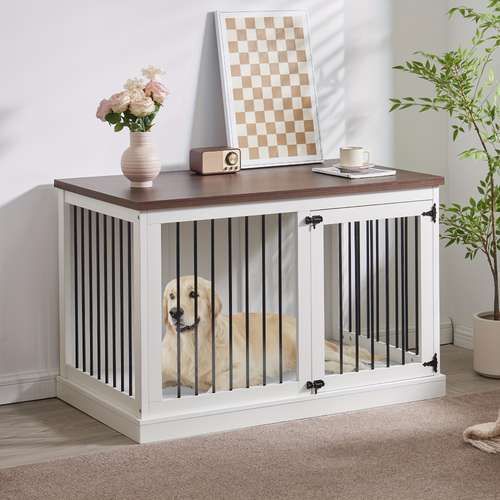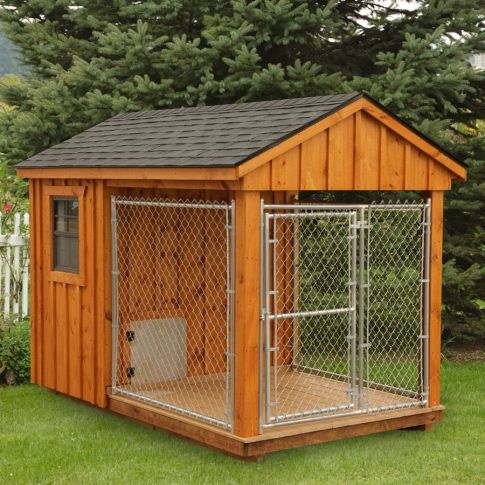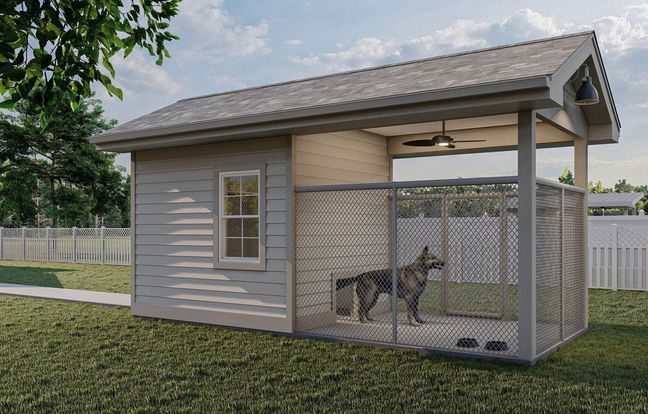Understanding Different Dog Breeds’ Needs

When it comes to picking the right kennel for your dog, it’s important to understand that no two breeds are alike. Dogs, like people, have their own unique personalities, preferences, and physical needs. Some dogs love the idea of cozying up in a small space, while others may feel confined and uncomfortable in anything but an open area. Knowing what your dog needs based on their breed will help you make smarter decisions and keep your pup happy and secure.
Let’s dive into the unique needs of different dog breeds and how you can choose a kennel that matches their personality and lifestyle!
Small Breeds: The Comfort Lovers
Small dogs, like Chihuahuas and Pomeranians, are often known for being little bundles of energy. However, they also have a tendency to crave comfort and warmth. If you’ve ever noticed how your small dog loves to snuggle in blankets or burrow under cushions, you’ll know what we mean. These tiny companions enjoy kennels that feel like a cozy den, offering them a sense of security and warmth.
For these small breeds, choosing a kennel that’s not too large is key. While it may seem like a bigger kennel would give them more space to move around, many small dogs actually feel safer in a more confined space. Look for kennels with soft padding or even those with a blanket or plush liner to create the perfect snuggly spot. Don’t forget to keep it in a warmer part of the house—small dogs get cold faster than their larger counterparts!
Medium Breeds: The Active Explorers
Medium-sized breeds, like Cocker Spaniels and Bulldogs, strike a balance between energy and relaxation. These dogs often have periods of playfulness followed by a long nap to recharge. When it comes to kennels, medium breeds tend to enjoy a space that’s not only comfortable but also gives them room to stretch out. A kennel that’s too tight could leave them feeling cramped, while one that’s too large might not feel cozy enough.
For medium dogs, it’s all about finding that sweet spot. Look for kennels that allow them to stand up, turn around, and comfortably lie down. These dogs will also benefit from a kennel with ventilation, as they can sometimes get hot after a play session. You might also want to add a soft bed or cushion inside, so your medium-sized friend has a comfy place to relax after a day of fun. Medium breeds are versatile, so whether they’re lounging indoors or outside, a kennel that fits their size and energy level will keep them content.
Large Breeds: The Gentle Giants
If you own a large dog, like a Great Dane or a German Shepherd, you already know that these gentle giants need plenty of space to feel comfortable. These dogs are big in size, but also in heart! They tend to be calm, easy-going companions, but that doesn’t mean they don’t need a bit of extra attention when it comes to their kennel setup. Large breeds often need more than just a kennel—they need space to stretch, lay down, and relax without feeling squeezed.
For large dogs, opt for a kennel that is spacious enough for them to stand tall and move around with ease. Heavy-duty kennels are usually the best choice for larger breeds, as they’re designed to handle the size and strength of bigger dogs. You’ll want to make sure the kennel has solid construction, especially if you’re using it outdoors, to ensure your dog feels safe and secure. Adding a durable, supportive bed inside the kennel will make it even more comfortable for your big dog. Trust us, your gentle giant will appreciate the extra room and sturdy design.
Matching Your Dog’s Personality
Of course, it’s not just about size—your dog’s personality plays a huge role in determining their kennel needs. A highly active breed, like a Border Collie or a Husky, will need a kennel that allows for plenty of ventilation to keep them cool after a day of running around. These dogs often enjoy having some toys or interactive elements in their kennel to keep them engaged when they’re resting.
On the other hand, more laid-back breeds, like Basset Hounds or Shih Tzus, may prefer a quieter, more enclosed kennel where they can relax without too much outside distraction. These dogs might enjoy a kennel with soft materials or extra bedding that lets them sink in and take a long nap after a leisurely stroll.
Understanding your dog’s temperament and preferences will help you create a kennel environment that they love. If your dog enjoys a peaceful retreat, choose a kennel that feels more like a personal den. If they’re the curious type, try adding features that allow them to see out or interact with their surroundings.
Indoor vs. Outdoor Kennels: What’s Best?
When it comes to choosing the perfect kennel for your dog, you might be wondering: should you go with an indoor or outdoor kennel? It’s a common dilemma for dog owners, and there’s no one-size-fits-all answer. Your dog’s breed, personality, and lifestyle all play a role in determining which option is the best fit. But don’t worry—whether you’re leaning toward keeping your pup cozy inside or letting them enjoy the fresh air outside, we’ve got you covered.
Let’s break down the pros and cons of indoor and outdoor kennels so you can make the best decision for your furry friend.
Indoor Kennels: Cozy Comfort for Your Pup

Indoor kennels are great if you want to keep your dog close by, especially in colder or unpredictable weather. These kennels are perfect for creating a snug, comfortable space for your dog right inside your home. If your dog loves being around the family and enjoys the warmth and coziness of the indoors, then an indoor kennel might be just what they need.
The best part about indoor kennels is that they’re ideal for keeping your dog safe and secure while still being part of the household action. Whether you’re busy cooking in the kitchen or having a movie night in the living room, your dog can have their own little haven without being far from the family. You can easily place their favorite bed or blanket inside, and they’ll have a cozy nook to retreat to whenever they need a break.
For smaller dogs or breeds that prefer being close to their owners, indoor kennels offer a sense of security. They’re also a great option if you have a puppy or an older dog that needs a bit more supervision. Plus, with indoor kennels, you don’t have to worry about weather changes or outdoor noise disrupting your dog’s peace.
However, indoor kennels do come with a few considerations. If you have a large dog or a breed that loves to move around, an indoor kennel could feel a bit restrictive if it’s too small. You’ll need to make sure there’s enough space for your dog to stand up, turn around, and lie down comfortably. And, of course, regular cleaning is a must to keep the area fresh and hygienic.
Outdoor Kennels: Freedom and Fresh Air

If your dog loves spending time outside, an outdoor kennel might be the perfect solution. Outdoor kennels give your dog a taste of freedom while still keeping them safe and secure in a designated area. Whether it’s enjoying the sunshine, fresh air, or simply watching the world go by, an outdoor kennel offers your dog a space to relax and explore without the need for constant supervision.
Outdoor kennels are especially great for active or larger breeds. If your dog has lots of energy to burn, being outside gives them a bit more room to stretch their legs, even while inside the kennel. You can add toys, water, and comfy bedding to keep them entertained and comfortable while they’re outside. And for dogs that love being in nature, an outdoor kennel can be a great way to keep them engaged with their surroundings.
Another big benefit of outdoor kennels is that they can be larger than indoor ones. If you have a spacious backyard, you can create an outdoor kennel that offers plenty of room for your dog to move around. Many outdoor kennels are made from durable materials like heavy-duty steel or wood, providing both security and sturdiness. Some even come with built-in shelters, so your dog has a shaded spot to retreat to when they need a break from the sun or wind.
But outdoor kennels do have some downsides to consider. Depending on your climate, outdoor kennels may not be suitable year-round. Extreme temperatures—whether hot or cold—can make outdoor kennels uncomfortable for your dog. You’ll need to ensure the kennel is properly sheltered and insulated to protect your dog from harsh weather conditions. And don’t forget, outdoor kennels require regular cleaning and maintenance to keep them in tip-top shape!
Finding the Perfect Balance
So, indoor or outdoor—what’s the final verdict? It all depends on your dog’s needs, your living situation, and what you’re looking for in a kennel. Some dog owners even opt for a combination of both, using an indoor kennel during cold or rainy days and letting their dog enjoy an outdoor kennel when the weather is nice.
If you have a dog that craves social interaction and wants to be near the family, an indoor kennel might be the best fit. On the other hand, if your dog thrives on outdoor activity and loves having space to roam, an outdoor kennel could give them the freedom they need.
It’s also worth considering your daily routine. If you’re home most of the day, an indoor kennel allows your dog to stay close while still having a designated space. But if you’re away for long periods and have a secure outdoor area, an outdoor kennel offers your dog the opportunity to enjoy fresh air and a bit of outdoor stimulation while you’re gone.
Customizing Your Dog’s Kennel Experience
No matter which option you choose, you can always customize the kennel to suit your dog’s specific needs. Add comfy bedding, favorite toys, and water to keep them hydrated and happy. If you have an outdoor kennel, think about adding a cover or insulated area to shield your dog from harsh weather. Indoor kennels, on the other hand, can be placed in quiet corners of your home, giving your dog a peaceful retreat whenever they need it.
At the end of the day, the best kennel for your dog is one that suits their personality and lifestyle. Take your time to consider how much space they need, whether they enjoy indoor coziness or outdoor adventure, and how you can make their kennel a place they’ll love. With a little thought and effort, you’ll find the perfect balance between indoor and outdoor options—giving your dog a safe, comfortable, and happy space to call their own.
Key Features to Look for in a Kennel
Choosing the right kennel for your dog is about more than just size and style. It’s about making sure your dog feels comfortable, secure, and happy in their little retreat. Whether you’re looking for an indoor or outdoor kennel, there are certain key features you’ll want to keep an eye on to ensure it’s the perfect fit for your furry friend. Let’s break down some of the most important features that will make your dog’s kennel both functional and cozy.
1. Size: Enough Room to Move and Stretch
First and foremost, size matters! One of the biggest mistakes dog owners make when choosing a kennel is not considering their dog’s size and how much room they’ll need to feel comfortable. You want your dog to have enough space to stand up, turn around, and lie down without feeling cramped.
If the kennel is too small, your dog may feel confined and uncomfortable, which defeats the purpose of providing a safe space. On the other hand, if the kennel is too big, your dog might feel lost in it and not as secure. A kennel should feel like a cozy den, not an oversized room. A good rule of thumb is to measure your dog from nose to tail and add a little extra space for comfort.
For puppies or growing dogs, it’s a good idea to invest in a kennel with adjustable dividers. This way, you can start with a smaller space and gradually expand it as your puppy grows. You’ll get more use out of the kennel without needing to upgrade as they get bigger!
2. Material: Durability and Comfort Combined
The material of your dog’s kennel plays a huge role in its overall durability and comfort. There are a variety of materials to choose from, including plastic, metal, wood, and fabric, each offering its own pros and cons.
Plastic kennels are lightweight, easy to clean, and provide a cozy, enclosed feel for your dog. They’re great for travel or for dogs who prefer a more private space. Metal kennels, particularly those made from sturdy steel, are excellent for large or strong dogs who need a bit more durability. They offer excellent ventilation and visibility, allowing your dog to feel connected to their surroundings.
Wooden kennels can be aesthetically pleasing and often provide great insulation for outdoor use. However, they can be a bit trickier to clean and maintain. For indoor use, fabric kennels are an option for smaller dogs or those who love a soft, cozy space. They’re easy to move around but may not hold up as well for dogs who like to chew or scratch.
When picking a material, think about your dog’s habits. Are they chewers? Do they love to scratch or dig? You want a kennel that can withstand your dog’s behavior while also being comfortable for them to rest in.
3. Ventilation: Fresh Air, Happy Pup
No matter where you place your dog’s kennel—indoors or outdoors—ventilation is a must. Proper airflow helps keep the kennel from getting stuffy, especially during warm weather, and ensures your dog stays comfortable.
Kennels with mesh sides, open panels, or slotted bars are ideal for ensuring there’s enough fresh air circulating inside. If you’re going for a plastic or enclosed kennel, make sure there are air vents or windows built into the design. For outdoor kennels, ventilation is especially important since your dog will be exposed to different weather conditions. You want to make sure they stay cool in the summer and have proper shelter in the colder months.
Good ventilation also helps prevent bad odors from building up inside the kennel, keeping it fresher for longer. Plus, it gives your dog the chance to look out and feel connected to their environment while still enjoying their private space.
4. Security: Safe and Snug
Security is another crucial factor when choosing a kennel. You want to make sure your dog feels safe inside, but also that they stay secure and can’t escape. For indoor kennels, look for sturdy latches or locks that are easy for you to open but impossible for your dog to figure out. Some dogs are little Houdinis when it comes to escaping, so it’s important to pick a kennel that can outsmart them!
If you’re selecting an outdoor kennel, security becomes even more important. You’ll need to ensure the kennel is solid and weather-resistant, with strong doors and fencing that can’t be pushed open. Make sure there’s a good locking mechanism, especially if your dog is prone to exploring when you’re not around.
For those with large or strong dogs, heavy-duty kennels made of metal or steel are often the best option. They’re designed to withstand some rough handling, so even the most energetic pups won’t break out.
5. Portability: Easy to Move When Needed
Whether you’re looking for a kennel for travel, or just one that’s easy to move around the house, portability is a great feature to consider. Many plastic or fabric kennels are lightweight and come with handles or wheels, making it easy to transport them when necessary. This is especially useful if you like taking your dog on trips or need to move the kennel between rooms.
If you’re opting for a larger, more permanent kennel, consider one with detachable parts or panels. Some heavy-duty kennels can be taken apart and reassembled, making them easier to clean or move when needed. Portability may not be a top priority for everyone, but it’s definitely a feature worth thinking about, especially if you’re frequently on the go.
Maintaining Comfort and Safety in Kennels
When it comes to keeping your dog’s kennel both comfortable and safe, there are a few key steps you can take to ensure your pup feels happy, secure, and cozy in their little haven. A kennel should be more than just a containment area—it should feel like a personal retreat where your dog can relax and enjoy some downtime. With a few simple tweaks, you can create an ideal environment that meets both your dog’s comfort needs and safety requirements.
Let’s explore how to maintain a kennel that keeps your furry friend comfy and safe, whether they’re snoozing indoors or lounging outdoors.
1. Comfort Starts with the Right Bedding
The first step in creating a cozy kennel environment is choosing the right bedding. No one likes sleeping on a hard surface, and your dog is no different! Adding soft, comfortable bedding is essential to making your dog’s kennel feel like a comfy retreat. There are tons of options to consider, from plush dog beds to memory foam mats, all designed to give your pup a soft place to rest.
If you’re using an indoor kennel, you can opt for cushioned bedding that provides support and warmth. Dogs love a snug, soft spot where they can curl up, so look for a bed that fits perfectly inside the kennel. Make sure it’s washable too, because, let’s face it, dogs aren’t always the tidiest creatures!
For outdoor kennels, consider more durable and weather-resistant bedding options. Water-resistant or elevated beds are ideal for outdoor use since they help keep your dog dry and comfortable even if the kennel gets a bit damp. Just make sure the bedding is easy to clean and can handle the elements, so your dog has a cozy spot rain or shine.
2. Climate Control: Keep Your Dog Cool and Warm
Whether your dog’s kennel is indoors or outdoors, maintaining the right temperature is crucial to their comfort and well-being. Too hot or too cold, and your dog could become uncomfortable or even unwell, so paying attention to climate control is a must.
For indoor kennels, make sure the room your dog’s kennel is in isn’t too drafty or exposed to extreme temperatures. You can place the kennel in a quiet corner away from windows or doors to keep things stable. In colder months, you can add a blanket or thermal pad inside the kennel to keep your dog warm and cozy. During warmer months, proper ventilation is key, so make sure the kennel has plenty of airflow to avoid overheating.
If your dog uses an outdoor kennel, extreme weather is a bigger concern. Outdoor kennels should be well-insulated to protect your dog from harsh temperatures. In hot weather, you might want to add a kennel fan or shade cover to keep things cool. In the winter, look for outdoor heating pads or insulated dog houses to ensure your pup stays warm. A comfortable kennel is one that adjusts to the weather, keeping your dog feeling great no matter what’s happening outside.
3. Regular Cleaning: Fresh and Hygienic
Maintaining cleanliness is essential for your dog’s health and comfort, and it doesn’t have to be a chore if you stay on top of it. A clean kennel not only keeps your dog happy but also prevents the build-up of bacteria, bad odors, and even pests.
Indoor kennels are typically easier to keep clean since they’re inside your home, but they still require regular attention. Wipe down the walls of the kennel with a pet-safe cleaner and wash your dog’s bedding frequently to avoid odors and dirt. Make it a habit to do a quick spot clean every day, picking up any shed fur, dirt, or leftover food. This helps keep the kennel fresh and inviting for your dog.
Outdoor kennels require a bit more effort, especially if your dog spends a lot of time outside. Make sure to clean up any waste promptly and hose down the kennel floor regularly. Using removable, washable bedding is helpful here, as it makes cleaning much easier. Outdoor kennels are also exposed to the elements, so inspect for any dirt, bugs, or debris that may have collected and keep things tidy. Your dog will appreciate a fresh, clean space to rest!
4. Safety Measures: Keep Your Pup Secure
Safety should always be a priority when maintaining your dog’s kennel. A kennel should be a place of security, not one of risk. Whether you’re using it to keep your dog safe indoors or outside, ensuring your pup’s environment is secure is essential for their well-being.
Start by checking the kennel’s structure to ensure it’s sturdy and free from any sharp edges or loose parts. If your dog is an escape artist, make sure the kennel door has a secure latch or lock that they can’t easily figure out. You don’t want your dog wandering off unsupervised, especially in an outdoor environment.
If your dog spends time in an outdoor kennel, be sure the kennel is placed in a shaded, safe area of your yard. You don’t want your dog to be too exposed to the sun, rain, or other elements. It’s also important to consider the flooring—if the kennel is on grass, check regularly for any holes or uneven ground that could cause injury. For kennels with metal bars, inspect them regularly to make sure they’re not rusting or becoming weak over time.
In terms of safety, make sure your dog has access to fresh water at all times, whether they’re in an indoor or outdoor kennel. A water bowl that attaches to the side of the kennel can be a great way to prevent spills and ensure they stay hydrated.



